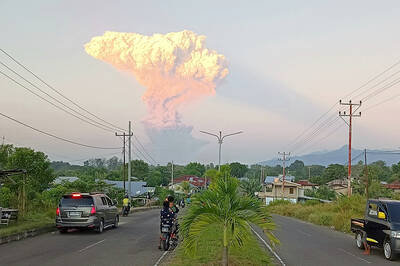Arthropleura, the biggest bug ever known at up to 3.2m long, inhabited North America and Europe at a time when Earth’s atmospheric oxygen levels surged, helping some plants and animals grow to gigantic proportions.
While its fossils have been known since 1854, a large gap has existed in the understanding of the creature because none of the remains had a well-preserved head.
The discovery in France of two Arthropleura fossils with intact heads has now remedied this, providing the anatomical details needed for scientists to classify it as a huge primitive millipede and determine it was not a predator, but rather a plant eater.
The fossils, hich were unearthed in Montceau-les-Mines, are of juvenile individuals that lived in a tropical climate and a swampy environment lush with vegetation.
While Arthropleura was this ecosystem’s behemoth, the fossils preserve young individuals just 4cm long.
The fossils showed Arthropleura’s head was roughly circular, with slender antennae, stalked eyes and mandibles fixed under it. It had two sets of feeding appendages, the first short and round, and the second elongated and leg-like.
The specimens each had 24 body segments and 44 pairs of legs — 88 legs in total. Based on its mouthparts and a body built for slow locomotion, the researchers said that Arthropleura was a detritivore like modern millipedes, feeding on decaying plants, rather than a predator like centipedes.
It could have served the same role in its ecosystem as elephants today or big dinosaurs like the long-necked sauropods in the past — “a big animal spending most of his time eating,” said paleontologist Mickael Lheritier of the Laboratory of Geology of Lyon at Claude Bernard University Lyon 1 in France, lead author of the study published this week in the journal Science Advances.
“I think it is quite a majestic animal. I think its gigantism gives it a peculiar aura, like the aura of whales or elephants,” Lheritier said. “I love to imagine it as the ‘cow’ of the Carboniferous, eating during most of the day — but, of course, a cow with an exoskeleton and many more legs.”
Other examples of ancient arthropod gigantism included Meganeura, an eagle-sized dragonfly, and Pulmonoscorpius, a scorpion more than 1m long.

Former Nicaraguan president Violeta Chamorro, who brought peace to Nicaragua after years of war and was the first woman elected president in the Americas, died on Saturday at the age of 95, her family said. Chamorro, who ruled the poor Central American country from 1990 to 1997, “died in peace, surrounded by the affection and love of her children,” said a statement issued by her four children. As president, Chamorro ended a civil war that had raged for much of the 1980s as US-backed rebels known as the “Contras” fought the leftist Sandinista government. That conflict made Nicaragua one of

COMPETITION: The US and Russia make up about 90 percent of the world stockpile and are adding new versions, while China’s nuclear force is steadily rising, SIPRI said Most of the world’s nuclear-armed states continued to modernize their arsenals last year, setting the stage for a new nuclear arms race, the Stockholm International Peace Research Institute (SIPRI) said yesterday. Nuclear powers including the US and Russia — which account for about 90 percent of the world’s stockpile — had spent time last year “upgrading existing weapons and adding newer versions,” researchers said. Since the end of the Cold War, old warheads have generally been dismantled quicker than new ones have been deployed, resulting in a decrease in the overall number of warheads. However, SIPRI said that the trend was likely

BOMBARDMENT: Moscow sent more than 440 drones and 32 missiles, Volodymyr Zelenskiy said, in ‘one of the most terrifying strikes’ on the capital in recent months A nighttime Russian missile and drone bombardment of Ukraine killed at least 15 people and injured 116 while they slept in their homes, local officials said yesterday, with the main barrage centering on the capital, Kyiv. Kyiv City Military Administration head Tymur Tkachenko said 14 people were killed and 99 were injured as explosions echoed across the city for hours during the night. The bombardment demolished a nine-story residential building, destroying dozens of apartments. Emergency workers were at the scene to rescue people from under the rubble. Russia flung more than 440 drones and 32 missiles at Ukraine, Ukrainian President Volodymyr Zelenskiy

Indonesia’s Mount Lewotobi Laki-Laki yesterday erupted again with giant ash and smoke plumes after forcing evacuations of villages and flight cancelations, including to and from the resort island of Bali. Several eruptions sent ash up to 5km into the sky on Tuesday evening to yesterday afternoon. An eruption on Tuesday afternoon sent thick, gray clouds 10km into the sky that expanded into a mushroom-shaped ash cloud visible as much as 150km kilometers away. The eruption alert was raised on Tuesday to the highest level and the danger zone where people are recommended to leave was expanded to 8km from the crater. Officers also